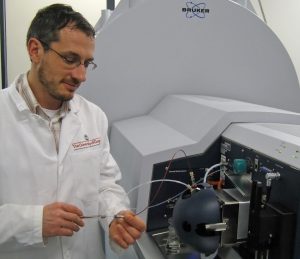Study Identifies Molecular Fingerprints for Tracking Oil and Dispersant Fate
– December 22, 2015
An international science team examined the effects of dispersant on the activity and composition of oil-degrading marine microorganisms.The researchers found that the biodegraded oil-derived compounds exhibited a specific molecular composition that distinguished them from naturally occurring dissolved organic matter.
The presence of dispersants combined with available nutrients may have affected the type of organic compounds degraded and the metabolic pathways of biodegradation. The researchers published their findings in Deep Sea Research II: Topical Studies in Oceanography: Biodegradation of crude oil and dispersants in deep seawater from the Gulf of Mexico: Insights from ultra-high resolution mass spectrometry.
The challenging task of quantifying the chemical composition of oil and weathered oil from the Deepwater Horizon spill has been the focus of past studies and continues with ongoing investigations. The researchers in this study applied similar analytical techniques to characterize the molecular formulae and compositional changes of oil and dispersant-derived compounds during biodegradation in laboratory incubations that used Macondo surrogate oil, Corexit 9500, and deep Gulf water samples.
Michael Seidel, the study’s lead author, explained how dispersants may have affected microbial oil degradation, “The addition of dispersant in our experiments led to an increase of sulfur-containing organic molecular formulae, which were probably derived from the surfactant di-octyl sulfosuccinate (DOSS), an important component of several chemical dispersants.” He continued, “We were able to assign structures to several of these molecules, and we propose that they are DOSS degradation products and other dispersant components.”
Patricia Medeiros, the study’s corresponding author, noted that the discovery of a specific molecular composition for water-soluble oil fractions is “an important step towards the identification of oil molecular fingerprints that can be useful to identify future oil spill sources.” Seidel explained a unique aspect of this study, “We were able to show preferential degradation, transformation, and enrichment of distinct organic compounds when DOSS is used to chemically disperse oil.” Medeiros said that it will be important to continue studying these compounds to track and understand the fate of dispersants in the marine environment.
The study’s authors are Michael Seidel, Sara Kleindienst, Thorsten Dittmar, Samantha B. Joye, and Patricia M. Medeiros.
************
This research was made possible in part by a grant from the Gulf of Mexico Research Initiative (GoMRI) to the Ecosystem Impacts of Oil and Gas Inputs to the Gulf (ECOGIG) consortium.
The Gulf of Mexico Research Initiative (GoMRI) is a 10-year independent research program established to study the effect, and the potential associated impact, of hydrocarbon releases on the environment and public health, as well as to develop improved spill mitigation, oil detection, characterization and remediation technologies. An independent and academic 20-member Research Board makes the funding and research direction decisions to ensure the intellectual quality, effectiveness and academic independence of the GoMRI research. All research data, findings and publications will be made publicly available. The program was established through a $500 million financial commitment from BP. For more information, visit https://gulfresearchinitiative.org/.
© Copyright 2010- 2017 Gulf of Mexico Research Initiative (GoMRI) – All Rights Reserved. Redistribution is encouraged with acknowledgement to the Gulf of Mexico Research Initiative (GoMRI). Please credit images and/or videos as done in each article. Questions? Contact web-content editor Nilde “Maggie” Dannreuther, Northern Gulf Institute, Mississippi State University (maggied@ngi.msstate.edu).






